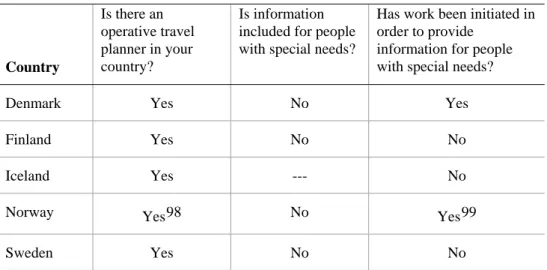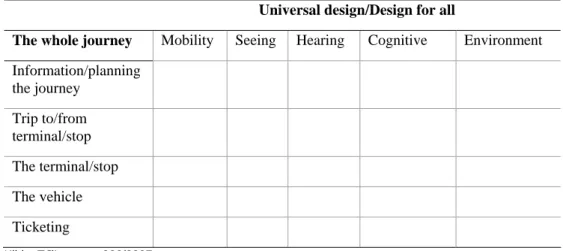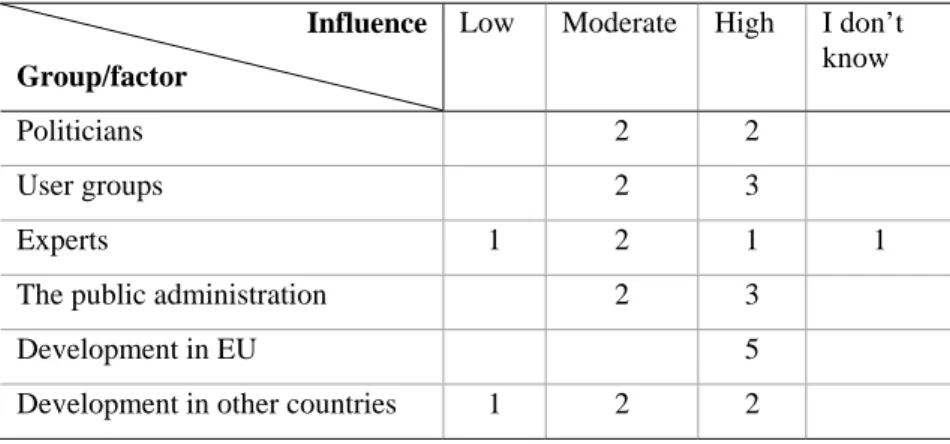Policies, legal frameworks and other means for improving accessibility of public transport systems in the. Accessibility of public transport systems is a necessity for independent living, social inclusion and sustainable development.
Background
The need for accessible public transport systems
It requires not just accessible vehicles – buses, coaches, trams, trains, etc., but also an accessible environment in the broadest sense. Because people with disabilities generally tend to be worse off than their able-bodied peers, financial assistance is also important.
Objectives of this work
To be truly effective, it must be part of broader policies and legislation, including areas such as land use, health, education and social policy.
Methodology and data collection
By national travel planners we mean websites that list (all) public transport services in the country, with the necessary information to plan a trip. All documents in the inventory are also listed in the references (but not vice versa).
EU policy and strategies
The Commission will therefore promote accessible public transport, which is an important contribution to the ability to work.
EU legislation
On the rights of disabled and reduced mobility persons when traveling by air (Regulation (EC) No 1107/2006). Regulation (EC) No 1107/2006 on the rights of disabled and reduced mobility persons when traveling by air11.
Denmark
All the Nordic countries have, or are in the process of developing, policy documents and action plans for more accessible public transport systems. We find that the Finnish accessibility strategy and the associated ELSA research and development program together with the Norwegian BRA program are the documents that contain the most detailed and concrete action plans.
Finland
Iceland
Norway
The White Paper presented a new accessibility action plan; Action Plan for BRA - Public Transport Program (Ministry of Transport and Communications 2006). The main goal of the action plan is greater accessibility of public transport for everyone, with special emphasis on disabled people.
Sweden
A priority in this action plan is accessible public transport for people with disabilities and people with reduced mobility. In this overview of the legal frameworks in the Nordic countries, our focus is on the laws, provisions and regulations related to the accessibility of public transport systems.
Laws, provisions and regulations
It has been our ambition to include all areas of the legal frameworks specifically related to accessible public transport by road, but we cannot be sure that we have covered everything. Sweden, Finland and Denmark have laws requiring operators or municipalities to consider the needs of disabled people when planning and organizing public transport services. The planning part of the planning and building orders is often omitted when discussing planning and building orders as a means of promoting accessible public transport systems51.
Section 1, §2 of the Swedish Constitution53 states that "public institutions shall fight against discrimination against persons on the basis of sex, skin color, national or ethnic origin, linguistic or religious affiliation, functional disability, sexual orientation, age or other circumstances affecting a private person". The law stipulates that operators must take disabled people into account when planning and implementing public transport services. The Planning and Construction Act (1987)60, provisions on accessibility61 and the Act on Technical Requirements for Construction62 state that new buildings and their surroundings must be designed to take into account the needs of everyone, including people with mobility impairments.

Implementation of some EU directives in national legislation
In Finland, the older national provisions not requiring accessible buses in urban transport are still in force – alongside Directive 2001/85/EC. So far, there are no accessibility requirements when public transport is procured by the Provincial State Offices (lääninhallitus in Finnish). The current financial framework and model only allow for the age of the equipment in question.
Regarding the transport of services at the community level, there are practices in Finland to take into account the accessibility of vehicles and equipment, and this has improved significantly. Iceland replied that the acts of the European Union are regularly applied in the agreement on the European Economic Area. The Directorate of Health and Social Affairs has drawn up guidelines for universal design in public procurement66 (SHdir 2007), but these are not part of the legal framework.
Standards and guidelines
Progress has been made, and accessibility and user-friendliness are included in the quality. Among other things, there are requirements about accessibility for new trains in the contracts for the purchase of transport services between the Ministry of Transport and Communications and the Norwegian State Railways (NSB). For "the whole journey", the Ministry mapped the current situation in the publication Accessibility and compatibility of travel methods.
Transport and infrastructure as well as public transport services are dealt with in the guidance. Guidelines linked to the Planning and Building Act are also referred to in the response from the Swedish Ministry of Business, Energy and Communications. Through the door-to-door project, knowledge has been acquired that is now being transformed into standards and guidelines for the "entire journey".
Employment and education issues
Regarding accessibility of railway systems, the Ministry of Business refers to various EU documents in connection with the ongoing work with new technical specifications for interoperability. These are the trans-European rail system for conventional and high-speed trains – Technical specification for interoperability (EC 2006b) 87, the working document on the EC Decision for TSI persons with reduced mobility (EC 2006a)88 and annexes to the TSI(EC 2005)89. The government has tasked the Roads Agency and the Rail Agency with presenting an action plan for the long-term development of public transport90.
One of the priorities of this action plan is accessible public transport for disabled people and people with reduced mobility. In this chapter, we only refer to the information we received from the ministries via questionnaires. There were no reviews or cross-checks, but the people who answered the questionnaires read the text and made the necessary corrections.
Reducing individual economic barriers
The municipality provides severely disabled people with the transport services required to work, study, participate in society and for recreation. In Iceland, it is up to each municipality to decide whether ticket prices should be lowered for certain groups of people. From 1988, the county councils in Norway organized a specially adapted transport offer (AT service) for residents who, due to various severe disabilities, cannot use ordinary public transport.
The purpose of the AT-service is to enable disabled people to participate in local social activities. The AT service is organized as an individual door-to-door taxi service, but at a reduced price. As already described, there is also a system of organized specially adapted transport for residents who cannot use normal public transport due to a number of different severe disabilities.
Incentives to encourage accessibility of public transport systems
In 2006, a new subsidy scheme of NOK 50 million was introduced in the budget of the Ministry of Transport and Communication94. The purpose of this grant scheme is to encourage local governments at provincial and municipal levels to prioritize universal design and accessibility for all passengers by funding 75% of local initiatives, and to support efforts to improve accessibility. The Swedish Ministry of Enterprise, Energy and Communication says it has no requirements for accessibility in the budgets.
More information on subsidies is available in the Public Roads Authority's Handbook for Government Contributions to Certain Public Transport Facilities95 (Swedish Roads Authority 2004).
Training
The group has started preparations to establish a prize for projects that improve accessibility in public space or transport. The material has also been distributed by various players (Finavia, the state company responsible for airports, the Finnish Maritime Administration, etc.) and organizations (e.g. the Association of People with Mobility Disabilities). Those who work in design and construction receive training in the individual areas both in education and on the job.
Training focused on accessibility and persons with disabilities is available for public transport staff (mainly drivers) in two provinces. The Public Transport Authority in the Scania region, Skånetrafiken, supports people with disabilities who want to try to use public transport97. The National Road Administration offers courses to understand functional disabilities in the field of road traffic.
Indicators
Various Public Transport Authorities train drivers and other service staff in how to act to help and support people with problems when using public transport. This includes a web page aimed at persons with disabilities who wish to use public transport, with information on vehicles, access, tickets, etc. We also know that topics related to accessible public transport systems at universities etc.
Networking
Influence of various groups
National travel planners
Danish Trip Planner does not offer specific information for people who need detailed accessibility knowledge. 98 The national travel planner does not include local transport in Norway's second largest city, Bergen. 99 Information about accessibility and facilities at stops, stations and terminals is planned to be included in the trip planner (we assume that this is the case in all countries, but only the Norwegian respondent included this information in the answer).
It has been suggested that the journey planner should contain information that helps people with special needs find the information they need (Ministry of Transport and Communications 2003). This means that the National Travel Planner is not the property or responsibility of any national authority. The provision of information in the national travel planner is supported by government regulations that oblige all public transport companies to regularly provide up-to-date information about lines and timetables104.

Discussions
None of the ministries, except Sweden, reported that legal systems require operators or others to provide travel information to persons with special needs. Looking at the legal framework, we find that Finland and Norway have accessibility as one of the main objectives in their Land Use and Building Act/Planning and Building Act, and this will also be the case in the new Icelandic Building and Planning Act. We have not found that this part of the journey is directly covered by other laws, provisions or regulations.
We thus find that there are intentions in some of the countries' policies and legal frameworks to make this part of the journey accessible. It seems that Finland and Norway have come the furthest compared to the Nordic countries in integrating the ideals of universal design and the Whole Journey into their politics. Finland seems to be the only country that has discussed maintenance as part of accessibility policy in a systematic way.

Challenges
Nationell specialtrafiktjänstlagen, Sverige (lag 1997:736 om färdtjänst och lag 1997:735 om Riksfärttjänst) http://www.notisum.se/rnp/SLS/LAG/19970735.HTM Norska vägmyndigheter (1993): Vägar och gator Utformningsanvisningar. Island http://www.nat.is/travelguideeng/bus_travel_planner_around_.htm Norge http://rutebok.no/.
